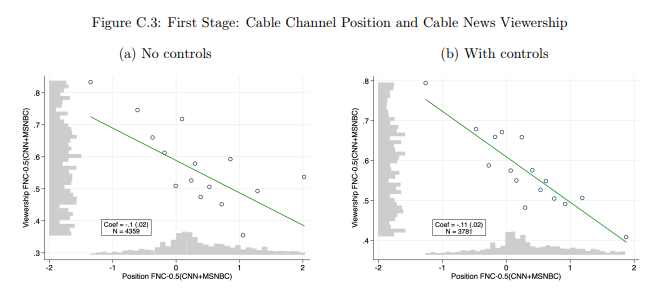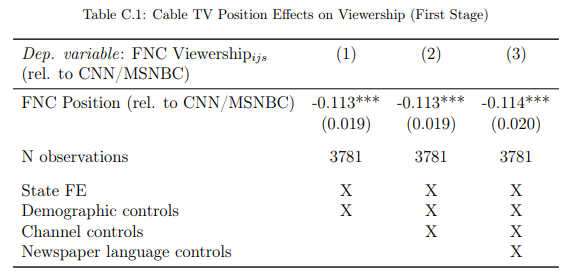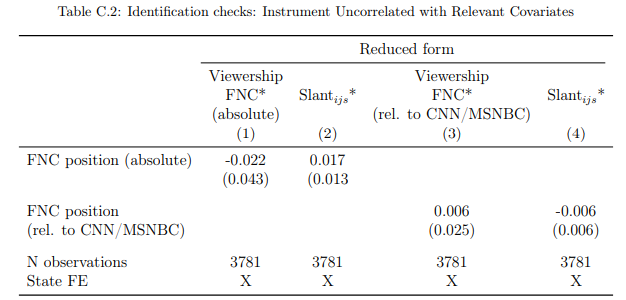and the distribution of digital products.
DM Television
First Stage Results of Our Media Bias Research
Abstract and 1 Introduction 2. Data
3. Measuring Media Slant and 3.1. Text pre-processing and featurization
3.2. Classifying transcripts by TV source
3.3. Text similarity between newspapers and TV stations and 3.4. Topic model
4. Econometric Framework
4.1. Instrumental variables specification
4.2. Instrument first stage and validity
5. Results
6. Mechanisms and Heterogeneity
6.1. Local vs. national or international news content
6.2. Cable news media slant polarizes local newspapers
\ Online Appendices
A. Data Appendix
A.2. Alternative county matching of newspapers and A.3. Filtering of the article snippets
A.4. Included prime-time TV shows and A.5. Summary statistics
B. Methods Appendix, B.1. Text pre-processing and B.2. Bigrams most predictive for FNC or CNN/MSNBC
B.3. Human validation of NLP model
B.6. Topics from the newspaper-based LDA model
C. Results Appendix
C.1. First stage results and C.2. Instrument exogeneity
C.3. Placebo: Content similarity in 1995/96
C.8. Robustness: Historical circulation weights and C.9. Robustness: Relative circulation weights
C.12. Mechanisms: Language features and topics
C.13. Mechanisms: Descriptive Evidence on Demand Side
C.14. Mechanisms: Slant contagion and polarization
C. Results Appendix C.1. First stage results
\

In this Section, we follow Ash and Galletta (2023) to demonstrate that our instrument is unrelated to demographic characteristics that predict policy preferences or news channel viewership. We use linear regressions with demographic characteristics and state fixed effects as covariates to predict viewership and newspaper content. Specifically, we obtain predictions related to the endogenous regressor (viewership) and to the outcome (the probability of newspaper content to be Fox-like). These predictions capture the variation in viewership and news content due to pre-existing cultural, economic, and political county characteristics.
\

\ We then regress these predictions on different definitions of our instrument Positionjs. Table C.2 summarizes this identification check. Columns 1 and 2 document that there is no significant relationship between the absolute position of Fox News and the predicted values for viewership or newspaper content. Columns 3 and 4 show that there is no significant relationship between relative FNC channel position and the respective predicted values. Overall, these results suggest that channel positions are not associated with county characteristics otherwise important for our endogenous regressor or outcome.
\
:::info This paper is available on arxiv under CC 4.0 license.
:::
:::info Authors:
(1) Philine Widmer, ETH Zürich and [email protected];
(2) Sergio Galletta, ETH Zürich and [email protected];
(3) Elliott Ash, ETH Zürich and [email protected].
:::
\
- Home
- About Us
- Write For Us / Submit Content
- Advertising And Affiliates
- Feeds And Syndication
- Contact Us
- Login
- Privacy
All Rights Reserved. Copyright , Central Coast Communications, Inc.